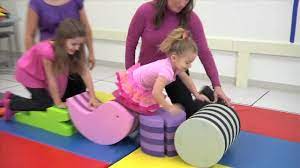Physical Therapy

When a baby suffers Erb’s palsy, the importance of ongoing therapy cannot be overstated.
The initial assessment should be performed by a physician experienced in assessment and treatment of erb’s palsy. They will assess your baby’s capability to use his or her arm and hand and shoulder, and try to clinical determine which nerves within the brachial plexus are injured. As your child grows, they will asess their ability to perform bimanual activities of daily living or ADLs, basic self care activities, including feeding, dressing, bathing, grooming, hygiene, play skills, recreation and social participation. They will assess your child for weakness in the shoulder, elbow, forearm, wrist, finger, and hand.
Erb’s Palsy can affect the ability to reach, grasp, lift, and carry objects.
Sundholm’s landmark 1998 Swedish study of children with neonatal BPI (erb’s palsy) showed that 95% of studied children with deficits in shoulder, biceps, or hand function by age 3 months, did not have full recovery by 5 years. Overall 66% of children or two-thirds had problems by age 5 years secondary to muscle imbalance and residual symptoms. Results of this study indicate that the eventual outcome in upper plexus lesions is more complex than commonly believed. Based on their extensive research of pediatric obstetric BPI, both Sundholm and Nath recommend that it is important to describe BPI not only in terms of impairment but also disability. Incomplete recovery from BPI is more apparent in older children as daily upper limb tasks increase and become more complex, according to Duff’s 2015 article in Journal of Hand Therapy. According to Hulleberg’s 2014 study of 69 babies followed for 10-20 years, 80% of adolescents with birth BPI had substantial impairment in structure and function of the affected extremity, particularly in shoulder external rotation and asymmetric bimanual use of arms with compensatory movements to perform activities requiring specific positioning or movement.

A Swedish study by Strombeck published in Developmental Medicine and Child Neurology in 2007 reported considerable electromyographic changes in motor neurons of deltoid muscles, even in those children who appear to have fully recovered, and the motor neuron unit deteriorated over time. In 2004, Partridge and Edwards published findings in Physiotherapy Research International that 60% of adults surveyed with obstetric BPI (OBPI) had painful arthritic joints and 27% had scoliosis. More than half of patients in his group reported difficulty with dressing, bathing and cooking. A 2014 study by De Heer in Disability and Rehabilitation showed that many young adults with OBPI experienced limitations in daily functioning related to pain. 50% of participants complained about moderate or severe pain, which was located in the affected arm, the back and the non-affected arm. There reported an age-related increase in pain prevalence.
In 2015, both Duff in the Journal of Hand Therapy and Bellows in Physiotherapy Canada reported that coordination and balance may be affected in children with BPI secondary to the effects of muscle imbalance, postural asymmetry, and diminished sensation on sensorimotor development and gross motor delays.
Bellows cites findings that self-esteem was lower for participation in sports and motor activities in children with BPI in his 2015 study. Bellows also reports that 97% of children with BPI had postural control deficits that may contribute to decreasing function with increasing age.
According to a 2017 study by van der Holst et al. in the Journal Disability and Rehabilitation, a substantial proportion of adolescents and adults with neonatal BPI reported pain and restrictions in arm-hand functioning resulting in fair to poor societal participation, particularly in terms of choices regarding work and education, in addition to work performance. Tailored physical and psychosocial care was recommended to help prevent or address restrictions, which may improve participation.
Physical therapy and occupational therapy is critical to prevent these disabilities from becoming worse, and to maximize your child's capabilities.
Physical Therapy should begin as early as possible during the newborn period

